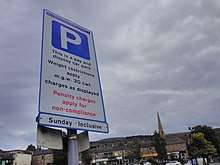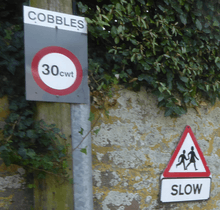Hundredweight
The hundredweight (abbreviation: cwt), formerly also known as the centum weight or quintal, British imperial and US customary unit of weight or mass. Its value differs between the US and British imperial systems. The two values are distinguished in American English as the "short" and "long" hundredweight and in British English as the "cental" and the "imperial hundredweight".
- The short hundredweight or cental of 100 pounds (45.36 kg) is used in the United States.[1]
- The long or imperial hundredweight of 8 stone or 112 pounds (50.80 kg) is defined in the imperial system.[2]
| hundredweight | |
|---|---|
| Unit system |
|
| Unit of | Mass |
| Symbol | cwt |

Under both conventions, there are 20 hundredweight in a ton, producing a "short ton" of 2,000 pounds and a "long ton" of 2,240 pounds.
History
The hundredweight has had many values. In England in around 1300, different "hundreds" (centum in Medieval Latin) were defined. The Weights and Measures Act 1835 formally established the present imperial hundredweight of 112 lb.
The United States and Canada came to use the term "hundredweight" to refer to a unit of 100 lb. This measure was specifically banned from British use—upon risk of being sued for fraud—by the Weights and Measures Act 1824 but, in 1879, the measure was legalized under the name "cental" in response to legislative pressure from British merchants importing wheat and tobacco from the United States.[3]
Use

The short hundredweight is commonly used in the US in the sale of livestock and some cereal grains[4] and oilseeds, paper, and concrete additives and on some commodities in futures exchanges.[5]
A few decades ago, commodities weighed in terms of long hundredweight included cattle, cattle fodder, fertilizers, coal, some industrial chemicals, other industrial materials, and so on. However, since increasing metrication in most English-speaking countries, it is now less used. Church bell ringers use the unit commonly,[6] although church bell manufacturers are increasingly moving over to the metric system.[7]
Older blacksmiths' anvils are often stamped with a three-digit number indicating their total weight in hundredweight, quarter-hundredweight (28 lb, abbreviated qr), and pounds. Thus, an anvil stamped "1.1.8" will weigh 148 lb (112 lb + 28 lb + 8 lb).[8]
The Imperial hundredweight is used as a measure of vehicle weight in the Bailiwick of Guernsey, although it was redefined as exactly 50.8 kg in 1991.[9]
See also
- Avoirdupois system
- The short and long hundred of 100 and 120, respectively
- Hundred, the medieval unit of measure
References
- "Special Publication 811 (Guide to the SI)". NIST. 3 December 2019. Retrieved 15 February 2020.
- Text of the UK Units of Measurement Regulations 1995 as originally enacted or made within the United Kingdom, from legislation.gov.uk. , which reiterates for hundredweight the Text of the Weights and Measures Act 1985 as in force today (including any amendments) within the United Kingdom, from legislation.gov.uk. .
- Chapter VII of the book Men and measures: a history of weights and measures, ancient and modern, by Edward Nicholson (published 1912). Downloadable at Archive.org.
- Murphy, William J. "Tables for Weights and Measurement: Crops". University of Missouri Extension". Archived from the original on 25 May 2007.
- "Rough Rice Futures - Contract specifications". Agricultural products. CME Group. Retrieved 21 December 2010.
- "Scope, Conventions, Abbreviations, etc". Doves Guide for Church Bell Ringers. Retrieved 21 December 2010.
- "Turret Bells". Whitechapel Bell Foundry Limited. Retrieved 21 December 2010.
- "Anvils-6: Marked Weight of Anvils". Getting Started in Blacksmithing. Retrieved 15 December 2014.
- "The Weights and Measures (Guernsey and Alderney) Law, 1991". Retrieved 29 October 2018.